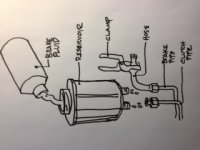sorry, away at MOTOGP, great stuff. In case of '67 Etype brake master & '65 Healey clutch done in past year: disconnect inlet pipe from reservoir to master at the master, put a short piece of rubber hose on metal line that is then clamped off so no additional fluid runs out of reservoir. Disconnect other pipe of master and without letting it drop down in vertical direction, keep it in place above master in vertical dimension (avoid fluid loss from that side of system). Take out old master, rebuild or replace, then bolt into car with piston moved all the way to the back of the car, as if it were connected to pedal lever--in fact if you are under there why not do now. Make some form of item such as turkey baster connected to a small diameter cupla inches of hose. Suck up some brake fluid, new or previously opened container as long as sealed well last time opened. Put hose in either of the two openings and 1) inject fluid until it flushes out of other opening, tapping master cylinder a few times with a wrench will jiggle loose air, or 2) if hose is flexible enough push it in most forward of two mast cyl holes and inject fluid while slowly withdrawing, or 3)before you put master cylinder in car, push piston all way in and gradually fill as you move cylinder all way out (bench bleeding). Once this phase is over you have mast cyl bolted into car with two holes pointing upwards and two lines waiting to be connected. The holes in the master cylinder should have plenty of fluid in them, and top up if not. Now place fitting on line coming from clutch/brake system into appropriate hole in master cylinder and tighten, some fluid should run out as space occupying nature of nut-like fitting will push excess out of orifice. Next, make sure reservoir is full, position line coming from reservoir so it can easily be put in remaining orifice in master cylinder. Remove rubber hose with clamp and now insert line into the orifice and tighten fitting. Fluid will flow readily through this connection until its end is screwed down tight--be careful of where this excess tablespoon or 2 of fluid may run such as onto footwell carpet. A hard and functional pedal should be felt, you not sure and want some extra security, the only air that could enter is if for some non Newtonian reason some dripped out of clutch/brake to master line I have always found that just a clear container with a hose from the slave bleed or furthest from master brake wheel bleed-let it gravity flow until color change which means new fluid in reservoir has made its way through system. Also the air tight connection the end of the metal line being driven down into the bottom of the orifice from the shape of the fitting pushing against the shape of the end of the tube which itself is driven down into the bottom of the orifice in the master where it will conform to an airtight seal. The threads are the source of the air-tight seal,although no harm would be done by using Teflon tape and who knows maybe the gods will shine and an error in the machining of threads will block a very tiny leak thanks to the tape. Since I have never purposefully changed fluid other than when wheel cylinder etc begins a leak for as long as 20 years in my old cars, a true never ever after usually about 8 years and 70, 000miles in my daily drivers before they are let loose with nary a millimeter drop in reservoir level ('02 Outback 90,000 never even had to top up fluid so far, changed pads once. The fluid that comes from the clutch slave or brake wheel bleed screws should be a distinctly less dark color than the fluid that comes out the bleed screw once new reservoir fluid appears--Such utter laxity and casualness regarding change intervals is a definite no no for raced or even track day cars. Good luck, Jay, '65 3000

 Hey there Guest!
Hey there Guest!
 smilie in place of the real @
smilie in place of the real @
 Pretty Please - add it to our Events forum(s) and add to the calendar! >>
Pretty Please - add it to our Events forum(s) and add to the calendar! >> 



 A friendly reminder - be careful what links you click on here. If a link is posted by someone you don't know, or the URL looks fishy, DON'T CLICK. Spammers sometimes post links that lead to sites that can infect your computer, so be mindful what you click.
A friendly reminder - be careful what links you click on here. If a link is posted by someone you don't know, or the URL looks fishy, DON'T CLICK. Spammers sometimes post links that lead to sites that can infect your computer, so be mindful what you click.